
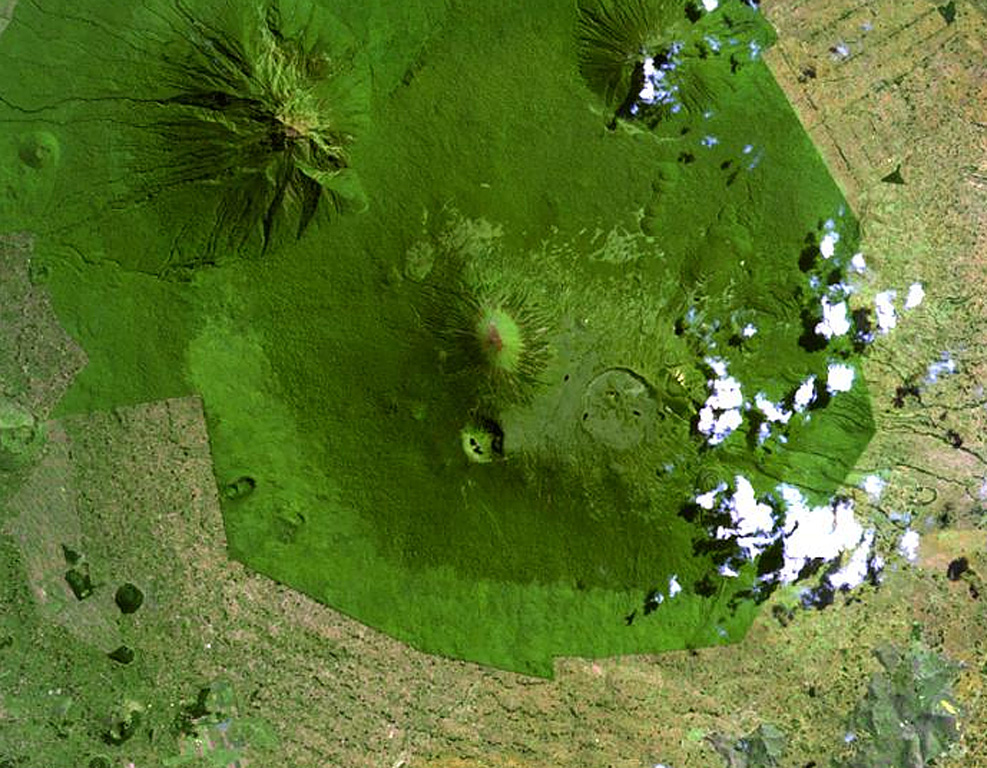
Rain-triggered mudflow causes 50 reported deaths in May 2010
The following report describes a mudflow that caused 50 deaths on 16 May 2010 on the outer W flank of Karisimbi, a complex volcano with steep upper slopes and the tallest of the Virunga volcanoes (figure 1). The first section was summarized from early reports by relief organizations. The second section is from a later report by Innocent Badryio (United Nations Office for Project Services, UNOPS), Benoít Smets (Royal Museum for Central Africa), and Dario Tedesco (Department of Environmental Sciences, University of Naples, Italy), which clarified the source of the event after field and remote sensing surveys.
Available reports did not attribute the mudflow to eruptive processes, seismicity, or gas emissions. Some early reports cited the sudden release of water from a crater lake, but that idea was later discounted. The later report (by Badryio, Smets, and Tedesco) attributed the mudflow to multiple factors, including heavy rains carrying loose debris into the regional drainage system. In addition, satellite images discussed in the later report revealed that the mudflows were more complex than the three branches that were reported initially (figure 2). Note that international boundary lines are not in agreement between figures 1 and 2.
Initial reports. UNOPS reported that human casualties and extensive property damage occurred on 16 May 2010, when a mudflow occurred ~6.5 km W of Karisimbi. The flow, composed of mud, tree debris, rock, and soil, occurred between 0000 and 0100, in the locality of Kibiriga, in the area of Kibumba, on the border of the DR Congo and Rwanda (figure 1). UNOPS described the affected area as "situated between a steep slope (45%) on the flank of Karisimbi and Mikeno to the NE and a sort of plain having a 10% steeper slope to the SW."
UNOPS reported that the mudflow was preceded by torrential rains that began at 2200 on 14 May and lasted until 0550 on 16 May. Based on initial field interpretation, UNOPS described the flow as "subdivided in three directions, with a thickness ranging between 0.3 to 4 m and a width of 50 to 150 m. The length of the flow could surpass 1 km, from the edge of Virunga Park, situated upstream from the locality, to the alluvial cone downstream."
Volcanic rocks were carried by the mudflows in some areas (figure 3). One branch of mud and debris, in the direction from NE to SW, flowed through part of Kibiriga village, causing human casualties and extensive damage to homes and crops (figures 4 and 5). The extent of the damage was due to a combination of factors, including the steep slope above the village, the amount and type of soil that was washed down the slope, and the type of housing in the area. Rising population densities have led to the destruction of forest and vegetation in the area, which may have contributed to the event.
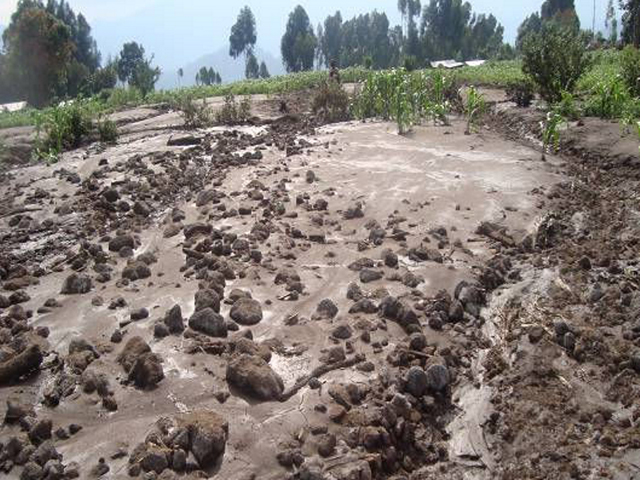 |
Figure 3. Volcanic rocks (on the order of decimeters) were carried by the mudflows in some areas near Karisimbi volcano on 16 May 2010. Courtesy of UNOPS. |
Figure 4 illustrates that houses in the area were substantial, built of mud bricks and wood. They contained large vertical timbers and horizontal interlacing branches of substantial strength. However, the houses proved unable to resist the impact of the deep and fast-moving mudflows, which UNOPS reported to flow at speeds higher than 50 km/hour in some places. Given the speed and because the flow occurred at night when residents were sleeping, they had little chance to escape.
Witnesses observed layers of older mudflows in the beds of two new streams after the event, which they interpreted to mean that similar events have occurred in the past. An elderly witness stated that similar events occurred in 1951, 1956, 1970, and 1994, but without casualties or much damage. This person also reported that the odor "of a pigsty" accompanied the 2010 mudflow. UNOPS stated that the mudflow was accelerated and especially violent because of the presence of volcanic ash and pieces of lava in the soil, and that similar events have occurred in the area every 12 years, on average.
Later analysis based on satellite data. Badryio, Smets, and Tedesco confirmed that such events are not unusual in the Virunga region and have occurred several times during the last century. This is because the main edifices of dormant volcanoes in the Virunga volcanic chain (in DR Congo, Rwanda, and Uganda) are cut by networks of deep gullies serving as ephemeral streams carrying water and debris from a large area. During exceptionally heavy rains, torrents are able to mobilize large amounts of unconsolidated pyroclasts and soil. The streams develop fast-moving and potentially devastating mudflows.
The extremely heavy, but not unusual, rainfalls that occurred in the Virunga region during April to May 2010 triggered several mudflows in DR Congo, and damage also occurred in neighboring Rwanda. Badryio, Smets, and Tedesco reported that the 16 May mudflow in the village of Kibiriga killed ~50 people and destroyed 232 houses and 7 hectares of crops. This particular mudflow reached at least 3 m deep and carried large blocks, including rocks more than 2 m wide.
Before this event, this hazard was poorly understood, and the origin of the mudflows was misattributed to drainage of a lake located in the Muntango crater (S crater of Karisimbi). Later field and remote sensing surveys coupled with a bibliographic review led to a revised description of the event and its impact. The mudflows were mapped using satellite images (EO1-ALI) that were geographically corrected (orthorectified) using other data. A 2.5-m resolution image (SPOT) and digital elevation model (DEM) were used for interpretation of the relief and the hydrographic networks. Based on the satellite data, scientists concluded that the lake in the Muntango crater was not the source of the mudflows.
Satellite imagery also revealed that the paths of the mud were more complex than three single branches (figure 2). The mudflows in Kibiriga followed the existing hydrographic network until they reached human-modified soils, where the mud spread laterally in several branches.
Scientists concluded that there is a danger of similar future events in this region, especially because of the exponential demographic and urban growth coupled with deforestation and the subsequent increase in soil erosion. UNOPS suggested a cartographic study to delineate zones at risk for future similar events.
Information Contacts: Innocent Badryio, United Nations Office for Project Services (UNOPS), Goma, Democratic Republic of Congo; Benoít Smets, Royal Museum for Central Africa, Department of Earth Sciences, Tervuren, Belgium; Dario Tedesco, Department of Environmental Sciences, University of Naples 2, Caserta, Italy; Observatoire Volcanologique de Goma, Departement de Geophysique, Centre de Recherche en Sciences Naturelles, Lwiro, D.S. Bukavu, DR Congo; United Nations Office for the Coordination of Humanitarian Affairs (UNOCHA), Kinshasa, DR Congo; World Health Organization, Bureau Du Representant De L’oms En Republique Democratique Du Congo (RDC), 42, Avenue des Cliniques, Gombe, Kinshasa.
The Global Volcanism Program has no Weekly Reports available for Karisimbi.
Reports are organized chronologically and indexed below by Month/Year (Publication Volume:Number), and include a one-line summary. Click on the index link or scroll down to read the reports.
Rain-triggered mudflow causes 50 reported deaths in May 2010
The following report describes a mudflow that caused 50 deaths on 16 May 2010 on the outer W flank of Karisimbi, a complex volcano with steep upper slopes and the tallest of the Virunga volcanoes (figure 1). The first section was summarized from early reports by relief organizations. The second section is from a later report by Innocent Badryio (United Nations Office for Project Services, UNOPS), Benoít Smets (Royal Museum for Central Africa), and Dario Tedesco (Department of Environmental Sciences, University of Naples, Italy), which clarified the source of the event after field and remote sensing surveys.
Available reports did not attribute the mudflow to eruptive processes, seismicity, or gas emissions. Some early reports cited the sudden release of water from a crater lake, but that idea was later discounted. The later report (by Badryio, Smets, and Tedesco) attributed the mudflow to multiple factors, including heavy rains carrying loose debris into the regional drainage system. In addition, satellite images discussed in the later report revealed that the mudflows were more complex than the three branches that were reported initially (figure 2). Note that international boundary lines are not in agreement between figures 1 and 2.
Initial reports. UNOPS reported that human casualties and extensive property damage occurred on 16 May 2010, when a mudflow occurred ~6.5 km W of Karisimbi. The flow, composed of mud, tree debris, rock, and soil, occurred between 0000 and 0100, in the locality of Kibiriga, in the area of Kibumba, on the border of the DR Congo and Rwanda (figure 1). UNOPS described the affected area as "situated between a steep slope (45%) on the flank of Karisimbi and Mikeno to the NE and a sort of plain having a 10% steeper slope to the SW."
UNOPS reported that the mudflow was preceded by torrential rains that began at 2200 on 14 May and lasted until 0550 on 16 May. Based on initial field interpretation, UNOPS described the flow as "subdivided in three directions, with a thickness ranging between 0.3 to 4 m and a width of 50 to 150 m. The length of the flow could surpass 1 km, from the edge of Virunga Park, situated upstream from the locality, to the alluvial cone downstream."
Volcanic rocks were carried by the mudflows in some areas (figure 3). One branch of mud and debris, in the direction from NE to SW, flowed through part of Kibiriga village, causing human casualties and extensive damage to homes and crops (figures 4 and 5). The extent of the damage was due to a combination of factors, including the steep slope above the village, the amount and type of soil that was washed down the slope, and the type of housing in the area. Rising population densities have led to the destruction of forest and vegetation in the area, which may have contributed to the event.
 |
Figure 3. Volcanic rocks (on the order of decimeters) were carried by the mudflows in some areas near Karisimbi volcano on 16 May 2010. Courtesy of UNOPS. |
Figure 4 illustrates that houses in the area were substantial, built of mud bricks and wood. They contained large vertical timbers and horizontal interlacing branches of substantial strength. However, the houses proved unable to resist the impact of the deep and fast-moving mudflows, which UNOPS reported to flow at speeds higher than 50 km/hour in some places. Given the speed and because the flow occurred at night when residents were sleeping, they had little chance to escape.
Witnesses observed layers of older mudflows in the beds of two new streams after the event, which they interpreted to mean that similar events have occurred in the past. An elderly witness stated that similar events occurred in 1951, 1956, 1970, and 1994, but without casualties or much damage. This person also reported that the odor "of a pigsty" accompanied the 2010 mudflow. UNOPS stated that the mudflow was accelerated and especially violent because of the presence of volcanic ash and pieces of lava in the soil, and that similar events have occurred in the area every 12 years, on average.
Later analysis based on satellite data. Badryio, Smets, and Tedesco confirmed that such events are not unusual in the Virunga region and have occurred several times during the last century. This is because the main edifices of dormant volcanoes in the Virunga volcanic chain (in DR Congo, Rwanda, and Uganda) are cut by networks of deep gullies serving as ephemeral streams carrying water and debris from a large area. During exceptionally heavy rains, torrents are able to mobilize large amounts of unconsolidated pyroclasts and soil. The streams develop fast-moving and potentially devastating mudflows.
The extremely heavy, but not unusual, rainfalls that occurred in the Virunga region during April to May 2010 triggered several mudflows in DR Congo, and damage also occurred in neighboring Rwanda. Badryio, Smets, and Tedesco reported that the 16 May mudflow in the village of Kibiriga killed ~50 people and destroyed 232 houses and 7 hectares of crops. This particular mudflow reached at least 3 m deep and carried large blocks, including rocks more than 2 m wide.
Before this event, this hazard was poorly understood, and the origin of the mudflows was misattributed to drainage of a lake located in the Muntango crater (S crater of Karisimbi). Later field and remote sensing surveys coupled with a bibliographic review led to a revised description of the event and its impact. The mudflows were mapped using satellite images (EO1-ALI) that were geographically corrected (orthorectified) using other data. A 2.5-m resolution image (SPOT) and digital elevation model (DEM) were used for interpretation of the relief and the hydrographic networks. Based on the satellite data, scientists concluded that the lake in the Muntango crater was not the source of the mudflows.
Satellite imagery also revealed that the paths of the mud were more complex than three single branches (figure 2). The mudflows in Kibiriga followed the existing hydrographic network until they reached human-modified soils, where the mud spread laterally in several branches.
Scientists concluded that there is a danger of similar future events in this region, especially because of the exponential demographic and urban growth coupled with deforestation and the subsequent increase in soil erosion. UNOPS suggested a cartographic study to delineate zones at risk for future similar events.
Information Contacts: Innocent Badryio, United Nations Office for Project Services (UNOPS), Goma, Democratic Republic of Congo; Benoít Smets, Royal Museum for Central Africa, Department of Earth Sciences, Tervuren, Belgium; Dario Tedesco, Department of Environmental Sciences, University of Naples 2, Caserta, Italy; Observatoire Volcanologique de Goma, Departement de Geophysique, Centre de Recherche en Sciences Naturelles, Lwiro, D.S. Bukavu, DR Congo; United Nations Office for the Coordination of Humanitarian Affairs (UNOCHA), Kinshasa, DR Congo; World Health Organization, Bureau Du Representant De L’oms En Republique Democratique Du Congo (RDC), 42, Avenue des Cliniques, Gombe, Kinshasa.
|
|
||||||||||||||||||||||||||
There is data available for 1 confirmed eruptive period.
8050 BCE (?) Confirmed Eruption (Explosive / Effusive)
| Episode 1 | Eruption (Explosive / Effusive) | |||||||||||||||||||
|---|---|---|---|---|---|---|---|---|---|---|---|---|---|---|---|---|---|---|---|
| 8050 BCE (?) - Unknown | Evidence from Isotopic: K/Ar | ||||||||||||||||||
|
List of 2 Events for Episode 1
|
|||||||||||||||||||
This compilation of synonyms and subsidiary features may not be comprehensive. Features are organized into four major categories: Cones, Craters, Domes, and Thermal Features. Synonyms of features appear indented below the primary name. In some cases additional feature type, elevation, or location details are provided.
Cones |
||||
| Feature Name | Feature Type | Elevation | Latitude | Longitude |
| Arbre | Cone | 3474 m | ||
| Bartholome, Pic | Stratovolcano | 4507 m | 1° 30' 0.00" S | 29° 27' 0.00" E |
| Bihiram | Cone | 2221 m | ||
| Bonde | Cone | 2545 m | ||
| Bugeshi | Cone | |||
| Bulengira | Cone | 1° 35' 0.00" S | 29° 20' 0.00" E | |
| Bundjuli | Cone | |||
| Bunyogwe | Cone | 1° 36' 0.00" S | 29° 20' 0.00" E | |
| Butaka | Cone | |||
| Gwanguoa | Cone | |||
| Hehu | Cone | 2430 m | 1° 30' 0.00" S | 29° 22' 0.00" E |
| Ingo | Cone | 2788 m | ||
| Kikombe | Cone | 1° 40' 0.00" S | 29° 17' 0.00" E | |
| Kinyangaki | Cone | |||
| Kirerema | Cone | 2394 m | ||
| Lukuka | Cone | |||
| Modenda | Cone | |||
| Mongomane | Cone | |||
| Musanula | Cone | |||
| Ntobe | Cone | |||
| Ruagare | Cone | 2363 m | 1° 35' 0.00" S | 29° 21' 0.00" E |
| Ruhara | Cone | 1° 36' 0.00" S | 29° 19' 0.00" E | |
| Rukondja | Cone | 1° 36' 0.00" S | 29° 19' 0.00" E | |
| Rungu | Cone | 1° 33' 0.00" S | 29° 21' 0.00" E | |
| Rushashu | Cone | |||
| Rwamisega | Cone | 1° 35' 0.00" S | 29° 20' 0.00" E | |
| Tsanzergwe | Cone | 1° 39' 0.00" S | 29° 20' 0.00" E | |
Craters |
||||
| Feature Name | Feature Type | Elevation | Latitude | Longitude |
| Branca, Caldera | Pleistocene caldera | 1° 31' 0.00" S | 29° 28' 0.00" E | |
| Mulderi | Crater | 1° 31' 0.00" S | 29° 28' 0.00" E | |
| Muntango
Hans Meyer Crater |
Pit crater | 1° 31' 0.00" S | 29° 26' 0.00" E | |
| Munyinya | Crater | 1° 31' 0.00" S | 29° 28' 0.00" E | |
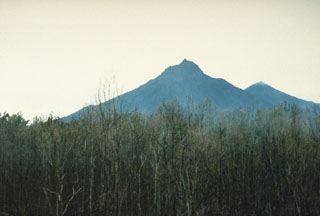 Mikeno volcano (center) and Karisimbi volcano (right) are seen here from the E on the flanks of Nyamuragira volcano. Mikeno is an eroded Pleistocene volcano; Karisimbi is younger. The 2-km-wide Branca caldera is located SE of the summit of Karisimbi and is filled by viscous lava flows and has two craters. More than 100 parasitic cones extend along a NNE-SSW zone to the shores of Lake Kivu.
Mikeno volcano (center) and Karisimbi volcano (right) are seen here from the E on the flanks of Nyamuragira volcano. Mikeno is an eroded Pleistocene volcano; Karisimbi is younger. The 2-km-wide Branca caldera is located SE of the summit of Karisimbi and is filled by viscous lava flows and has two craters. More than 100 parasitic cones extend along a NNE-SSW zone to the shores of Lake Kivu.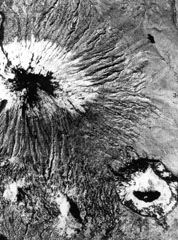 This aerial photo, with N to the upper left, shows Karisimbi (upper left) and the large 1.2-km-wide Muntango crater (lower right) located S of the summit; the 2-km-wide Branca caldera is located out of view to the right. The recent eruptions from Karisimbi produced a group of vents E of the caldera, which fed lava flows to the east, and the SW-flank lava vents.
This aerial photo, with N to the upper left, shows Karisimbi (upper left) and the large 1.2-km-wide Muntango crater (lower right) located S of the summit; the 2-km-wide Branca caldera is located out of view to the right. The recent eruptions from Karisimbi produced a group of vents E of the caldera, which fed lava flows to the east, and the SW-flank lava vents. The Karisimbi volcanic complex (center) includes a symmetrical, peaked summit flanked to the SE by the 2-km-wide Branca caldera, which is filled by viscous lava flows and two craters. The smaller Muntango crater is located S of the summit. A broad lava plain composed of flows erupted within the caldera and along a chain of parasitic cones, extends SW. Eroded Mikeno volcano is at the upper left and Visoke volcano at the upper right of this Landsat image.
The Karisimbi volcanic complex (center) includes a symmetrical, peaked summit flanked to the SE by the 2-km-wide Branca caldera, which is filled by viscous lava flows and two craters. The smaller Muntango crater is located S of the summit. A broad lava plain composed of flows erupted within the caldera and along a chain of parasitic cones, extends SW. Eroded Mikeno volcano is at the upper left and Visoke volcano at the upper right of this Landsat image.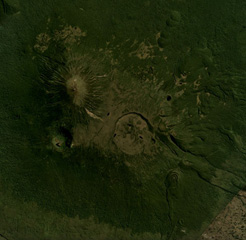 This June 2018 Planet Labs satellite image mosaic (N at the top) shows Karisimbi volcano of the Virunga volcanic field in Rwanda. The 1.5-km-wide Caldera Branca is seen near the center, with the summit to the NW and Mutango crater south of that. Extending SE of the caldera is a lava flow field with individual flows reaching 12 km in length.
This June 2018 Planet Labs satellite image mosaic (N at the top) shows Karisimbi volcano of the Virunga volcanic field in Rwanda. The 1.5-km-wide Caldera Branca is seen near the center, with the summit to the NW and Mutango crater south of that. Extending SE of the caldera is a lava flow field with individual flows reaching 12 km in length.There are no samples for Karisimbi in the Smithsonian's NMNH Department of Mineral Sciences Rock and Ore collection.
| Copernicus Browser | The Copernicus Browser replaced the Sentinel Hub Playground browser in 2023, to provide access to Earth observation archives from the Copernicus Data Space Ecosystem, the main distribution platform for data from the EU Copernicus missions. |
| MIROVA | Middle InfraRed Observation of Volcanic Activity (MIROVA) is a near real time volcanic hot-spot detection system based on the analysis of MODIS (Moderate Resolution Imaging Spectroradiometer) data. In particular, MIROVA uses the Middle InfraRed Radiation (MIR), measured over target volcanoes, in order to detect, locate and measure the heat radiation sourced from volcanic activity. |
| MODVOLC Thermal Alerts | Using infrared satellite Moderate Resolution Imaging Spectroradiometer (MODIS) data, scientists at the Hawai'i Institute of Geophysics and Planetology, University of Hawai'i, developed an automated system called MODVOLC to map thermal hot-spots in near real time. For each MODIS image, the algorithm automatically scans each 1 km pixel within it to check for high-temperature hot-spots. When one is found the date, time, location, and intensity are recorded. MODIS looks at every square km of the Earth every 48 hours, once during the day and once during the night, and the presence of two MODIS sensors in space allows at least four hot-spot observations every two days. Each day updated global maps are compiled to display the locations of all hot spots detected in the previous 24 hours. There is a drop-down list with volcano names which allow users to 'zoom-in' and examine the distribution of hot-spots at a variety of spatial scales. |
|
WOVOdat
Single Volcano View Temporal Evolution of Unrest Side by Side Volcanoes |
WOVOdat is a database of volcanic unrest; instrumentally and visually recorded changes in seismicity, ground deformation, gas emission, and other parameters from their normal baselines. It is sponsored by the World Organization of Volcano Observatories (WOVO) and presently hosted at the Earth Observatory of Singapore.
GVMID Data on Volcano Monitoring Infrastructure The Global Volcano Monitoring Infrastructure Database GVMID, is aimed at documenting and improving capabilities of volcano monitoring from the ground and space. GVMID should provide a snapshot and baseline view of the techniques and instrumentation that are in place at various volcanoes, which can be use by volcano observatories as reference to setup new monitoring system or improving networks at a specific volcano. These data will allow identification of what monitoring gaps exist, which can be then targeted by remote sensing infrastructure and future instrument deployments. |
| Volcanic Hazard Maps | The IAVCEI Commission on Volcanic Hazards and Risk has a Volcanic Hazard Maps database designed to serve as a resource for hazard mappers (or other interested parties) to explore how common issues in hazard map development have been addressed at different volcanoes, in different countries, for different hazards, and for different intended audiences. In addition to the comprehensive, searchable Volcanic Hazard Maps Database, this website contains information about diversity of volcanic hazard maps, illustrated using examples from the database. This site is for educational purposes related to volcanic hazard maps. Hazard maps found on this website should not be used for emergency purposes. For the most recent, official hazard map for a particular volcano, please seek out the proper institutional authorities on the matter. |
| IRIS seismic stations/networks | Incorporated Research Institutions for Seismology (IRIS) Data Services map showing the location of seismic stations from all available networks (permanent or temporary) within a radius of 0.18° (about 20 km at mid-latitudes) from the given location of Karisimbi. Users can customize a variety of filters and options in the left panel. Note that if there are no stations are known the map will default to show the entire world with a "No data matched request" error notice. |
| UNAVCO GPS/GNSS stations | Geodetic Data Services map from UNAVCO showing the location of GPS/GNSS stations from all available networks (permanent or temporary) within a radius of 20 km from the given location of Karisimbi. Users can customize the data search based on station or network names, location, and time window. Requires Adobe Flash Player. |
| DECADE Data | The DECADE portal, still in the developmental stage, serves as an example of the proposed interoperability between The Smithsonian Institution's Global Volcanism Program, the Mapping Gas Emissions (MaGa) Database, and the EarthChem Geochemical Portal. The Deep Earth Carbon Degassing (DECADE) initiative seeks to use new and established technologies to determine accurate global fluxes of volcanic CO2 to the atmosphere, but installing CO2 monitoring networks on 20 of the world's 150 most actively degassing volcanoes. The group uses related laboratory-based studies (direct gas sampling and analysis, melt inclusions) to provide new data for direct degassing of deep earth carbon to the atmosphere. |
| Large Eruptions of Karisimbi | Information about large Quaternary eruptions (VEI >= 4) is cataloged in the Large Magnitude Explosive Volcanic Eruptions (LaMEVE) database of the Volcano Global Risk Identification and Analysis Project (VOGRIPA). |
| EarthChem | EarthChem develops and maintains databases, software, and services that support the preservation, discovery, access and analysis of geochemical data, and facilitate their integration with the broad array of other available earth science parameters. EarthChem is operated by a joint team of disciplinary scientists, data scientists, data managers and information technology developers who are part of the NSF-funded data facility Integrated Earth Data Applications (IEDA). IEDA is a collaborative effort of EarthChem and the Marine Geoscience Data System (MGDS). |